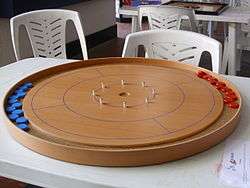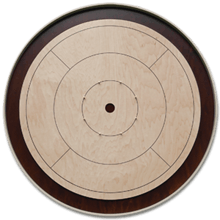Crokinole
Crokinole (/ˈkroʊkɪnoʊl/ KROH-ki-nohl) is a dexterity board game similar in various ways to pitchnut, carrom, marbles, shove ha'penny, with elements of shuffleboard and curling reduced to table-top size. Players take turns shooting discs across the circular playing surface, trying to have their discs land in the higher-scoring regions of the board, while also attempting to knock away opposing discs.
 A crokinole board | |
| Designer(s) | Eckhardt Reiner Elton Wettlaufer |
|---|---|
| Years active | ca. 1876– |
| Players | 2 or 4 |
| Skill(s) required | Fine motor skill, eye–hand coordination, intuitive understanding of physics & plane geometry |
Equipment

Board dimensions vary with a playing surface typically of polished wood or laminate approximately 26 inches (660 mm) in diameter. The arrangement is 3 concentric rings worth 5, 10, and 15 points as you move in from the outside. There is a shallow 20-point hole at the center.[1] The inner 15-point ring is guarded with 8 small bumpers or posts. The outer ring of the board is divided into four quadrants. The outer edge of the board is raised slightly to keep errant shots from flying out, with a gutter between the playing surface and the edge to collect discarded pieces. Crokinole boards are typically octagonal or round in shape. The discs are roughly checker-sized, slightly smaller in diameter than the board's central hole, and may have convex faces to reduce sliding friction. Alternatively, the game may be played with ring-shaped pieces with a central hole.
Powder
The use of any lubricating powder in crokinole is controversial, with some purists reviling the practice.
Powder is used to ensure pieces slide smoothly on the surface. According to carrom rules, the powder must be of high quality to keep the surface smooth and dry, and shall not be wet. Pouches and containers are used to spread the powder over the playing surface. There must be no impurity in the powder. Boric acid powder is mostly used for this purpose.
In the UK, many players use a version of anti-set-off spray powder, from the printing industry, which has specific electrostatic properties, with particles of 50-micrometre diameter (1.97×10−5 in). The powder is made of pure food-grade plant/vegetable starch.
Gameplay
Crokinole is most commonly played by two players, or by four players in teams of two, with partners sitting across the board from each other. Players take turns flicking their discs from the outer edge of their quadrant of the board onto the playfield. Shooting is usually done by flicking the disc with a finger, though sometimes small cue sticks may be used. If there are any enemy discs on the board, a player must make contact, directly or indirectly, with an enemy disc during the shot. If unsuccessful, the shot disc is "fouled" and removed from the board, along with any of the player's other discs that were moved during the shot.
When there are no enemy discs on the board, many (but not all) rules also state that a player must shoot for the centre of the board, and a shot disc must finish either completely inside the 15-point guarded ring line, or (depending on the specifics of the rules) be inside or touching this line. This is often called the "no hiding" rule, since it prevents players from placing their first shots where their opponent must traverse completely though the guarded centre ring to hit them and avoid fouling. When playing without this rule, a player may generally make any shot desired, and as long as a disc remains completely inside the outer line of the playfield, it remains on the board. During any shot, any disc that falls completely into the recessed central "20" hole (a.k.a. the "Toad" or "Dukie") is removed from play, and counts as twenty points for the owner of the disc at the end of the round, assuming the shot is valid.[2][3]
Scoring occurs after all pieces (generally 12 per player or team) have been played, and is differential: i.e., the player or team with higher score is awarded the difference between the higher and lower scores for the round, thus only one team or player each round gains points. Play continues until a predetermined winning score is reached.
History of the game
The earliest known crokinole board was made by craftsman Eckhardt Wettlaufer in 1876 in Perth County, Ontario, Canada. It is said Wettlaufer crafted the board as a fifth birthday present for his son Adam, which is now part of the collection at the Joseph Schneider Haus, a national historic site in Kitchener, Ontario, with a focus on Germanic folk art.[4] Several other home-made boards dating from southwestern Ontario in the 1870s have been discovered since the 1990s. A board game similar to crokinole was patented on 20 April 1880 by Joshua K. Ingalls (US Patent No. 226,615)[5][6]
Crokinole is often believed to be of Mennonite or Amish origins, but there is no factual data to support such a claim. The reason for this misconception may be due to its popularity in Mennonite and Amish groups. The game was viewed as a rather innocuous pastime – unlike the perception that diversions such as card playing or dancing were considered "works of the Devil" as held by many 19th-century Protestant groups.[7] The oldest roots of crokinole, from the 1860s, suggest the British and South Asian games are the most likely antecedents of what became crokinole.[8]
In 2006, a documentary film called Crokinole was released. The world premiere occurred at the Princess Cinema in Waterloo, Ontario, in early 2006. The movie follows some of the competitors of the 2004 World Crokinole Championship as they prepare for the event.[9][10]
Origins of the name
The name "crokinole" derives from croquignole, a French word today designating:
- in France, a kind of cookie (or biscuit in British English),[9] similar to a biscotto;
- in French Canada, a pastry somewhat similar to a doughnut (except for the shape).[11]
It also used to designate the action of flicking with the finger (Molière, Le malade imaginaire; or Voltaire, Lettre à Frédéric II Roi de Prusse; etc.), and this seems the most likely origin of the name of the game. Croquignole was also a synonym of pichenotte, a word that gave its name to the different but related games of pichenotte and pitchnut.
Crokinole is called knipsbrat ('flick-board') in the Low German spoken by Mennonites.
World Crokinole Championship
The World Crokinole Championship (WCC) tournament has been held annually since 1999 on the first Saturday of June in Tavistock, Ontario. Tavistock was chosen as the host city because it was the home of Eckhardt Wettlaufer, the maker of the earliest known board. The tournament has seen registration from every Canadian province, several American states, Germany, Australia, Spain and the UK.[12]
The reigning world adult singles crokinole champion is Justin Slater from London, Ontario.[13] The reigning world adult doubles champions are Jason Beierling of Kitchener, Ontario, and Ray Beierling of Dorchester, Ontario.[14]
The WCC singles competition begins with a qualifying round in which competitors play 10 matches against randomly assigned opponents. The qualifying round is played in a large randomly determined competition. At the end of the opening round, the top 16 competitors move on to the playoffs. The top four in the playoffs advance to a final round robin to play each other, and the top two compete in the finals. The WCC doubles competition begins with a qualifying round of 8 matches against randomly assigned opponents with the top six teams advancing to a playoff round robin to determine the champions.[15]
The WCC has multiple divisions, including a singles finger-shooting category for competitive players (adult singles), novices (recreational), and younger players (intermediate, 11–14 yrs; junior, 6–10 yrs), as well as a division for cue-shooters (cues singles). The WCC also awards a prize for the top 20-hole shooter in the qualifying round of competitive singles, recreational singles, cues singles, intermediate singles, and in the junior singles. The tournament also holds doubles divisions for competitive fingers-shooting (competitive doubles), novices (recreational doubles), younger players (youth doubles, 6–16yrs), and cues-shooting (cues doubles).
National Crokinole Association
The National Crokinole Association (NCA) is a federation that supports existing, and the development of new, crokinole clubs and tournaments. While the majority of NCA events are based in Ontario, Canada, the NCA has held sanctioned events in the Canadian provinces of PEI and BC, as well as in New York State.[16]
The collection of NCA tournaments is referred to as the NCA Tour. Each NCA Tour season begins at the Tavistock World Crokinole Championships in June, and concludes at the Ontario Singles Crokinole Championship in May of the following years. The results of each tournament award points for each player, as they compete for their season-ending ranking classification. The NCA Tour includes both doubles and singles events.[17]
The 2017-2018 NCA Tour Champion was Justin Slater, followed by Nathan Walsh in 2nd and Jon Conrad in 3rd.[18]
References
- http://www.crokinole.com/rules.asp
- Aubrey, Irene Elizabeth (1982). Sports and Games in Canadian Children's Books. National Library of Canada. ISBN 0-662-51763-6.
- Bell, R. C. (1979). Board and Table Games from Many Civilizations. Dover Publications. ISBN 0-486-23855-5.
- "Crokinole: City flickers revive a country pastime". Waterloo Region Record. 4 August 2015.
- "Patent Images". Retrieved 31 December 2016.
- "What is the history and background of the game of crokinole?". Retrieved 31 December 2016.
- "Crokinole". BoardGameGeek.com. Retrieved 31 December 2016.
- "Crokinole FAQ". www.crokinole.com. Retrieved 5 April 2017.
- Steckley, Jonathan; Steckley, Joshua (2006). Crokinole (DVD). Gillies Lake Productions.
- "Crokinole (2006)". The Internet Movie Database. Retrieved 3 January 2008.
- For a photo and a recipe, see: "Recette Croquignoles: Biscuits", CopuDePouce.com.
- "World's best crokinole players in Tavistock for saturday's World Championship". New Hamburg Independent. 27 May 2014.
- World Crokinole Championship https://www.worldcrokinole.com/results.html. Missing or empty
|title=(help) - "2018 Results". WorldCrokinole.com. World Crokinole Championship. 2018. Retrieved 17 June 2018.
- "Tournament Schedule". WorldCrokinole.com. World Crokinole Championship. 2017. Retrieved 22 July 2017.
- "NCA Home". nationalcrokinoleassociation.com. National Crokinole Association. 2018. Retrieved 30 September 2018.
- "NCA Home". nationalcrokinoleassociation.com. National Crokinole Association. 2018. Retrieved 30 September 2018.
- "Slater Takes Record 8th Ontario Title, 4th NCA Title". crokinolecentre.blogspot.com. CrokinoleCentre. 2018. Retrieved 30 September 2018.
External links
| Wikimedia Commons has media related to Crokinole. |